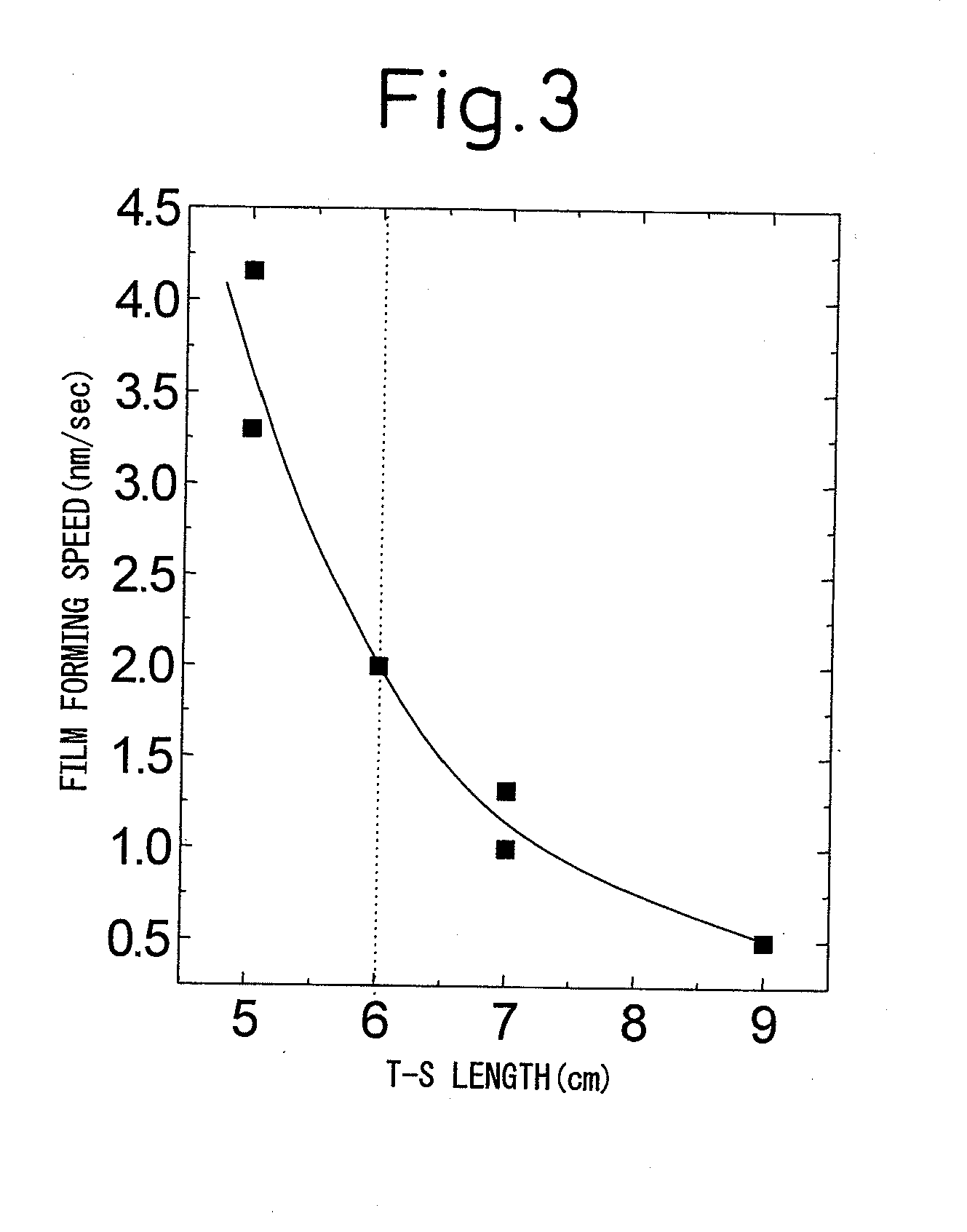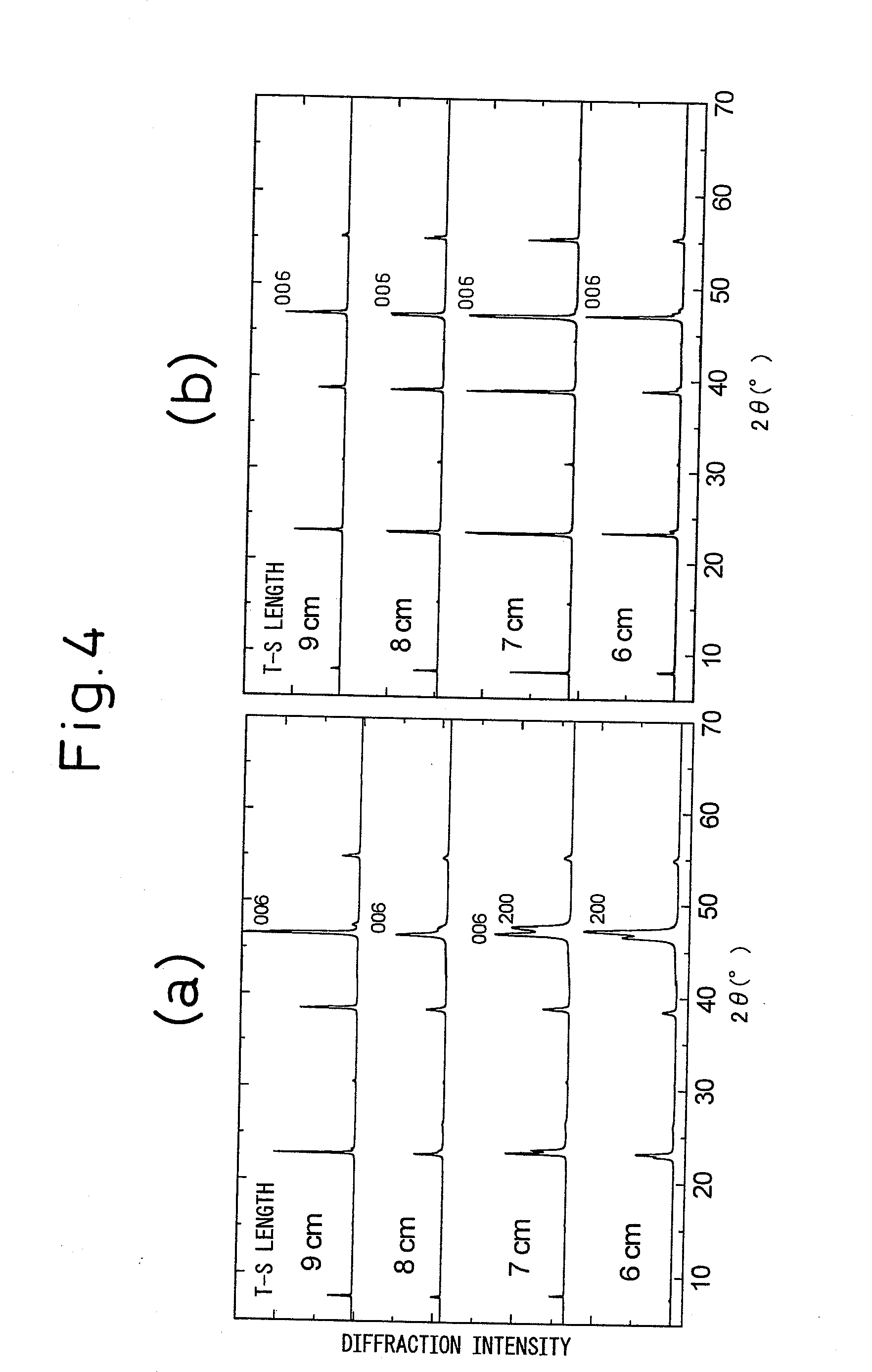Re123-based oxide superconductor and method of production of same
a superconductor and re123 technology, applied in the direction of superconductor details, superconductor devices, superconductor materials, etc., can solve the problem of limit to the improvement of critical current, and achieve the effect of good reproducibility of film properties and superior critical current characteristics
- Summary
- Abstract
- Description
- Claims
- Application Information
AI Technical Summary
Benefits of technology
Problems solved by technology
Method used
Image
Examples
example 1
[0238]Using a Gd0.9Ba2Cu3.3 oxide-based target (2Gd / Ba=0.90, 3Ba / 2Cu=0.91), a substrate comprised of Hastelloy covered by Gd2Zr2O7 and, furthermore, covered over that by CeO2 (ΔΦ=4.8°) was held in the plume (height 6 to 8 cm). The substrate was formed with a Gd123-based oxide superconducting film under a substrate temperature: 820 to 840° C., oxygen partial pressure in the atmosphere: 350 to 380 mmTorr, and the conditions shown in Table 3.
[0239]The thickness and structure (X-ray diffraction intensity ratio f a-axis crystal grains) of the grown Gd123-based oxide superconducting film are shown together in Table 4.
[0240]As shown in Table 4, the Gd123-based oxide superconducting films of samples a to e all had thicknesses of 3 μm or more. Their structures had a ratio of c-axis oriented crystals of 80% or more compared with the X-ray diffraction intensity ratio of a-axis crystal grains.
TABLE 4X-rayBasediffractionAdded non-materialPulse laserFilmintensitysuperconductingpositionenergyformi...
example 2
[0241]The Gd123-based oxide superconducting film of the sample a was measured for the critical current characteristic in a magnetic field. The results are shown in Table 5 and FIG. 15 and FIG. 16. Table 5 also describes the X-ray diffraction intensity ratio of a-axis crystal grains.
[0242]FIG. 15 shows the magnetic field strength dependency of the critical current characteristic in the case of applying a magnetic field B from 0.3 T to 7 T, while FIG. 16 shows the dependency of the critical current characteristic on the direction of application of the magnetic field.
TABLE 5Ic (3T)X-ray diffractionTargetIc (3T)(minimumintensity ratio of a-axismaterial(B / / c)value)crystal grainsGd0.9Ba2Cu3.3Oy56A46A3%
[0243]In FIG. 15, the black squares (B / / c) show the case of applying a magnetic field B in parallel to the c-axis of the crystals, while the black upside down triangles) (B / / c45°) show the case of applying a magnetic field B from a direction 45° from the c-axis of the crystals.
[0244]Even if ...
example 3
[0247]The Gd123-based oxide superconducting films (containing nonsuperconducting substances) of the samples b to e shown in Table 4 were measured for the critical current characteristic in the magnetic field. The results are shown in FIGS. 17 to 19. Further, the result is as shown in the above-mentioned Table 3.
[0248]From FIG. 17, it is learned that even if applying a magnetic field up to 7 T, a 10 A / cm width or more current will run through the Gd123-based oxide superconducting film. Such a high value is a value which cannot be obtained by the conventional PLD method.
[0249]From FIG. 18 and FIG. 19, it is learned that when applying a magnetic field B(3 T) vertically to the surface of the Gd123-based oxide superconducting film, at the very least a 72 A / cm width critical current is obtained.
[0250]This shows that in the superconducting phase of the RE123-based oxide superconducting film, there is cleavage of the current path due to the existence of a nonsuperconducting phase coarsened ...
PUM
| Property | Measurement | Unit |
|---|---|---|
| Fraction | aaaaa | aaaaa |
| Pressure | aaaaa | aaaaa |
| Magnetic field | aaaaa | aaaaa |
Abstract
Description
Claims
Application Information
 Login to View More
Login to View More - R&D
- Intellectual Property
- Life Sciences
- Materials
- Tech Scout
- Unparalleled Data Quality
- Higher Quality Content
- 60% Fewer Hallucinations
Browse by: Latest US Patents, China's latest patents, Technical Efficacy Thesaurus, Application Domain, Technology Topic, Popular Technical Reports.
© 2025 PatSnap. All rights reserved.Legal|Privacy policy|Modern Slavery Act Transparency Statement|Sitemap|About US| Contact US: help@patsnap.com



